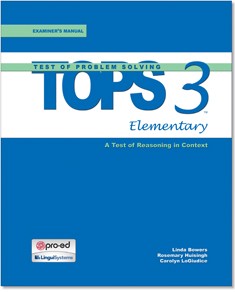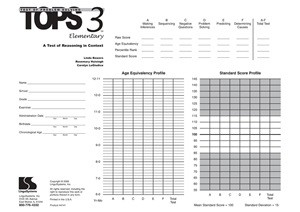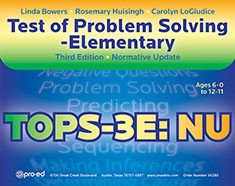Test of Problem Solving 3 (TOPS-3)
Elementary
COMPLETE KIT
- Ages 6 to 12
- Grades 1 - 7
- Testing Time 35 minutes
- Administration Individual
-
Product Code 34140 ( MR #059004 )
* Qualifications required to purchase this item. Click here to complete the qualifications form.
*DISCONTINUED (*NEW EDITION in Alternatives below)
The TOPS 3 Elementary focuses on the student's linguistic ability to think and reason. Language competence is the overall indicator of how a child's language skills affect his ability to think, reason, problem solve, infer, classify, associate, predict, determine causes, sequence, and understand directions. TOPS 3 Elementary test questions focus on a broad range of language-based thinking skills, including clarifying, analyzing, generating solutions, evaluating, and affective thinking.
While other tests may assess students' thinking skills by tapping mathematical, spatial, or nonverbal potential, the TOPS 3 Elementary measures discrete skills that form the foundation of language-based thinking, reasoning, and problem-solving abilities.
The test is composed of 18 situations that examine six thinking tasks. Carefully selected items and situations are relevant to most students and common across cultures and in most schools or home settings.
Although the skills tested on the TOPS 3 Elementary are necessary for developing social competence, it is not primarily a test of pragmatic or social language skills. Rather, it should be part of a battery of tests/observations used to assess pragmatic competence.
Subtests
The subtests consist of full-color photographs and questions that address critical thinking skills:
• Subtest A: Making Inferences
The student gives a logical explanation about a situation combining what he knows or can see with previous experiences and background information. The ability to infer is critical for success in the classroom, academics, and social development.
• Subtest B: Sequencing
The student determines and explains logical, everyday sequences of events. This skill is critical to academic performance and requires an understanding of the situation, determining the logical sequence of events, and expressing it clearly.
• Subtest C: Negative Questions
The student is asked to explain why something would not occur or why one shouldn't take a given action in a situation. Responses reveal how well your student notices, attends to, understands, and expresses an appropriate response on this subtest.
• Subtest D: Problem Solving
The student must recognize the problem, think of alternative solutions, evaluate the options, and state an appropriate solution that will work well. It also includes how to avoid specific problems.
• Subtest E: Predicting
This subtest requires the student to anticipate what will happen in the future. This requires him to draw from past experiences to reflect on the future. This skill is an academic as well as a life skill.
• Subtest F: Determining Causes
The student must give a logical reason for a given aspect of the situation in the paragraph. To be successful, the student must see the relationship between the action and the outcome.

 Proud to be Canadian
Proud to be Canadian


